People-centred designing
Use 'Print preview' to check the number of pages and printer settings.
Print functionality varies between browsers.
Printable page generated Friday, 19 April 2024, 11:51 AM
People-centred designing
1 Introduction
Designed products surround us all and range from bus tickets to buildings. One of the primary considerations in all fields of design is ‘usability’ and, increasingly, the phenomenon of ‘user-centred design’. This can focus on physical attributes of products but increasingly it depends on an understanding of our cognitive abilities required to operate even simple products. All people studying this course will have some experience of designs that are not usable (perhaps mobile phones or car controls). This course provides you with an introduction to the principles and procedures of design usability through the critical evaluation of selected products. Taking everyday examples, it develops students’ confidence and skills in critically evaluating products around them – particularly consumer products. This course aims to inform ‘consumers’ of design (i.e. all of us) about one important characteristic of design.
This OpenLearn course provides a sample of level 2 study in Design
Learning outcomes
After studying this course, you should be able to:
demonstrate a knowledge and understanding of the principles of user-centred designing
criticise some everyday products from a user's point of view
suggest and apply some appropriate methods for researching how users interact with products
apply comparison and evaluation skills, including constructive criticism of everyday products
apply observational skills in the context of both personal and others' use of products.
1 People-centred designing
This unit provides a taster of one of the most important concerns in product design - that the things we interact with with are both understandable and usable.
Unlike the toaster shown above, products should be user friendly. This applies to the cars we drive, the tools we use and the various computer devices we depend on to access information daily. Sadly, many products are not very usable. Mobile phones with unusable micro buttons, DVD recorders that cannot be understood, toasters that burn, jars with lids that cannot be removed. These are not failings on the part of the consumers – what is needed is a better and more people-centred design approach.
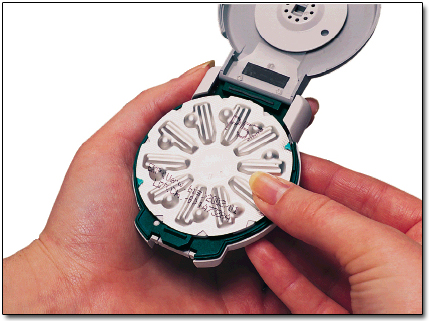
You do not need to be a designer, engineer or psychologist to study this course. It is aimed at those of us who consume design – which is everybody! This course will provide you with an introduction to some principles and techniques of people-centred design so that you might be empowered to offer better and more constructive criticism when things don't work – when product usability, particularly of consumer products, could be improved. Of course usability is just one of the many factors that designers need to be aware of. Products need to be manufacturable, they need to use materials that are suitable, they need to be sustainable and they need to be available to consumers at a certain price. Nevertheless, this course suggests that design must be first and foremost people-centred.
You might like to view these two short introductory video clips The first is Alison Black, (former) Head of Human Factors Design at the London office of the internationally renowned IDEO design consultancy. The second is James Dyson discussing usability issues of the DC01 bagless vacuum cleaner. Clicking on the play button will start each video.
Exercise 1 User friendly products
2 New products – old failings
This section introduces product ‘usability’. It offers a case study of a vegetable peeler to illustrate how usability issues exist alongside other important concerns in the product development process.
If you look around high-street or shopping-mall stores, you cannot help but notice the number and variety of new products on offer. This year's washing machine or dishwasher, stylish furniture, multi-feature telephones, audio systems, DVD players, digital cameras and camcorders, all beckon the shoppers, asking them to take note of recent developments. Similarly, press and TV advertisements, leaflets and Sunday supplement flyers introduce us to ranges of brand new, innovative products. New technology offers the potential for real improvements to our lives – products that make jobs easier, quicker or give better results. But all too often the conversion of a technology into an artefact results in products that are difficult to understand and use. Some ‘usability’ problems are very obvious and we see them before we buy. For example a mobile phone where the buttons seem too small for our fingers to operate or a camera that seems too complicated to understand. In these cases we have advance warning and can find alternative products to purchase. But many usability problems only become apparent AFTER we have purchased a product. One of the most important purposes of design is to represent the users in the product development process. Good design makes innovation understandable and usable for the intended market. But designing products to be usable is only one of many concerns for a manufacturer. Let's look at one recent example, the Good Grips vegetable peeler from the American OXO company.
Case study 1: OXO Good Grips vegetable peeler

Since the introduction of the first Good Grips peeler, many other products have been added to the OXO range – some are shown in Figure 2 – and many other producers have taken up the design, manufacturing and marketing principles embodied in the original product.
The OXO Good Grips peeler is not a typical example of new product development, in that it was conceived and developed by a single entrepreneur. More usually, new products arise within producer companies, from their deliberate programmes for new product development.
Test your understanding
What are the ‘failings’ referred to in the heading of this section?
Answer
My response
Many everyday products have annoying failures or weaknesses in their design – some could make the product dangerous. Often, it is not obvious how to use or operate them.
3 Designing for users
This section aims to develop your awareness of weaknesses in product designs, from the perspectives of usability and the variability in user populations, and to consider the opportunities for product design for different populations.
Although most producer companies devote major resources to researching the market for their products, many products still appear on the market that seem not to have been designed with their user in mind. You must have experienced or noticed some dangerous, baffling or irritating product design failures yourself. Perhaps sometimes you thought the failure lay with you, in not understanding how to use the product. Maybe you thought the designers just had not made the product sufficiently idiot-proof! But wait – you are not alone. Even professors of psychology get baffled by everyday objects. Here is a short extract from The Design of Everyday Things by Professor Donald Norman.
If I were placed in the cockpit of a modern jet airliner, my inability to perform gracefully and smoothly would neither surprise nor bother me. But I shouldn't have trouble with doors and switches, water faucets [taps] and stoves. ‘Doors?’ I can hear the reader saying, ‘You have trouble opening doors?’ Yes. I push doors that are meant to be pulled, pull doors that should be pushed, and walk into doors that should be slid. Moreover, I see others having the same troubles – unnecessary troubles. There are psychological principles that can be followed to make these things understandable and usable.
Click on 'View document' below if you would like to read more of Professor Donald Norman on 'The Design of Everyday Things'.
Test your understanding
Outline in your own words, in just one or two sentences, the main design principle that Donald Norman illustrates with his examples in the passage above.
Answer
My response
The design principle is visibility, which means making clear how a product operates or is used. Inadequate visibility leads to uncertainty, mistakes and rejection of the product; over-complexity (profusion of controls, and so on) leads to confusion and intimidation.
Why are so many everyday objects not only difficult to use but actually dangerous? Many domestic accidents are associated with using everyday objects such as scissors, knives, can-openers and garden tools and machines. These are perhaps inherently dangerous things that need care in their use, but many accidents also result from perfectly normal use of things such as cookers, heaters and even furniture. Of course, many domestic accidents involve young children, or elderly or infirm people; relatively young, healthy adults are less accident-prone. But surely designers realise that not everyone is a young, healthy adult?
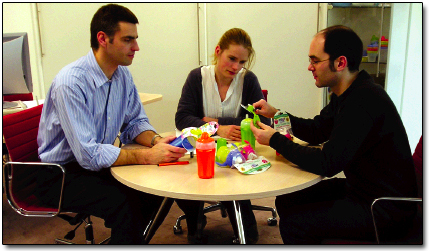
Most designers do recognise that often they are designing products for a wide range of users. It is not fair just to blame designers, when they are working to requirements laid down by producer companies and manufacturers, to quality standards set by retail company buyers, and to cost limits set by prices that consumers are prepared to pay.
Exercise 2 How things don't work
Take a look around your home or work environment. Think about the everyday objects you use as you go about your normal activities. Try to look at them with fresh eyes and become aware of shortcomings that you normally take for granted or products that you might blame yourself for not being able to use properly. Note down any problems you notice and try to think of ways in which they might be improved.
Having recently installed a new electric hob in my kitchen, I found that I was frequently turning the wrong knob for the hotplate I wanted. The layout of hotplates and control knobs is shown in here. Although each knob has an indicator alongside it of which hotplate it controls, it is still easy to make a mistake unless I consciously search through the indicators in order to find the right knob before turning it on.
The following example shows my attempt at this exercise.
Answer
There is no obvious way the four knobs in their present position can relate to the four hotplates, so until I have learned from considerable experience it will be necessary to look and choose consciously every time I want to turn on a hotplate. However, I suggest the control knobs could at least have been grouped in to two pairs, as shown in the animation above, so that the relationships could be more obvious.
4 Who are the users?
This section reveals that ‘users’ can include a wide variety of people – not just the final purchasers or consumers of a product. The section also makes the case for strong user representation in the design process.
Of course, it is not only me who uses the various products in my home; other people use them as well, both members of the family and visitors. Sometimes the range of users of a product, and their different needs, can be diverse. And in addition to the obvious or intended users there is a variety of people who have to interact with the product in various ways at different times, such as the people who make it or assemble it.
CYCLE OF USE AND THE USERS OF A PRODUCT
To manufacture the product people have to shape material, drill holes in components, and so on. During assembly people have to pick up the different pieces and put them together. During installation the product has to be transported, fitted into place, connections made and performance tested perhaps. The product has to be maintained and repaired by people during its working life. Finally, product components are often recycled or reprocessed; the different materials have to be separated and this is usually done by hand.
All these stages involve people in one way or another and so, ideally, a full usability evaluation would examine not only how well the product suited the capabilities, limitations and requirements of the user in the sense of the consumer, but all the other people who interact with it as well. For instance, how many times have you tried to repair something, only to find that you do not have the right tool, or the interior parts are inaccessible? These problems are widespread and they do not affect just the amateur at home. Most mechanics or service technicians will tell you stories about designs that make their jobs harder.
Manufacturing requirements can often override even needs. That is because manufacturing and assembly difficulties cost money through lost time, faulty products, accidents and worker dissatisfaction. I had a car once on which it was almost impossible to change one of the spark plugs because it was virtually out of reach behind other components, even when the special flexible plug spanner provided by the manufacturer was used. Of course, it was no trouble to insert the plugs before the distributor, carburettor, air filter, gear-shift connector, choke cable and so forth had been bolted on. In other words, the design is compatible with the requirements of one set of users (assemblers) at one stage in the product life cycle but not with the requirements of other users (service mechanics) at a later stage.
Test your understanding
What are the common issues in these examples in Section 5?
Answer
My response
The examples reveal that ‘users’ can include all those who interact with a particular product including those who make, assemble, purchase, and repair it, as well as those who operate it. The examples also reveal that many designs do not work well in use because the presence of the user is not strongly represented during design. The designer is subject to many, often conflicting pressures that require trade-offs to be made between users' needs and other factors.
5 Why not design for the ‘average’ user
This section explains why it can be misleading to design for an average user; a complete user population should be considered, and often it is more relevant to design for the smallest, tallest, weakest etc. Designing to include extreme users can also benefit the great majority of users.
Even when user needs are being considered in design, it is still relatively easy for the designer to fall into the trap of designing for the average user. On the face of it, it seems a good idea to design for the average user. Obviously people do vary but there are limits to variation and surely it should be possible to design around the needs of the majority of average people?
The problem is that although it is relatively easy, for example, to measure body dimensions of a large group of people and determine what the average values are, it is quite difficult to find individuals who are average in more than just a few of these.
An experiment conducted in the United States of America illustrates this point (Bailey, 1982). The averages of a large number of physical body dimensions such as standing height, arm length or chest circumference are already well known for US adult men. For this study, 4063 males were selected at random and measured to see how well they conformed to the known averages for their population. The first measurement was of standing height and out of the original sample of 4063, only 1055 or 25.9 per cent were found to be close to the average. The rest of the sample were allowed to go home and the experiment continued with only those who were of average height. They were next measured for chest circumference and it was found that only 302 or 7.4 per cent of this group were of both average height and chest measurement. All those not average in both respects were sent home and the experiment continued in this way, working through ten simple dimensions in all.
By the time the experimenters got to the tenth set of measurements only 2 subjects were left in the sample and after the tenth measurement even they were eliminated. They had run out of people to measure. No-one from the original sample of 4063 subjects was average in all 10 of the dimensions measured. The explanation is of course that every human being is unique, bodily dimensions vary quite widely both in terms of absolute size and in proportion to each other. In other words, the average person is rather unique.
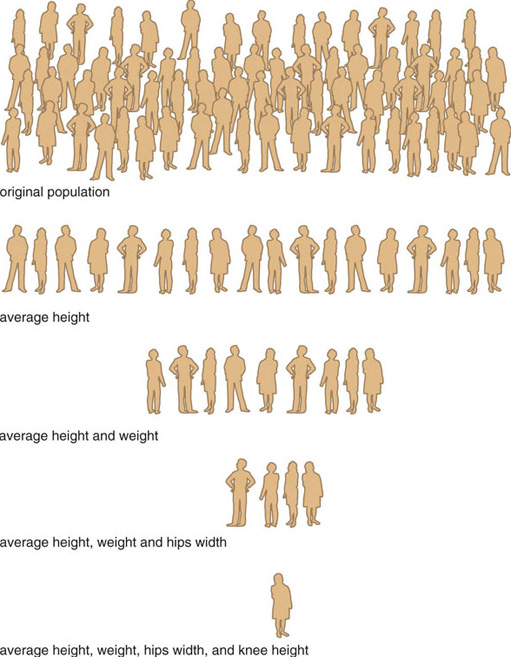
Nevertheless it is possible to define populations that have characteristics that are similar to or different from other populations. Generally speaking adults are taller than children, so age is one criterion we can use to define different user groups. Another is sex: men tend to be taller than women, although some women are of course taller than some men.
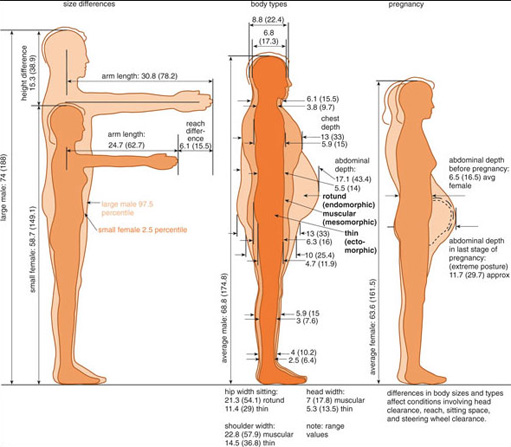
Physical condition is another way of looking at systematic variation between different populations. Pregnancy and obesity are conditions that have obvious implications for size and shape. Disabilities that limit movement or that affect physical size and shape may be another way of defining user populations usefully. Factors such as age, size, occupation, leisure interests and personal values may all be relevant characteristics in defining the user population. So when we talk about the typical user we need to make sure that we actually have a truly representative range of typical users in mind.
One common way of defining the range of a user population is the so-called method of extremes. Using this method, sample users are selected to represent the extremes of the user population plus one or two intermediate values. In a study to establish recommended kitchen work surface heights, three groups of sample female users were selected for the experiments (as seen in the animation above).
The shortest is around the 2.5th percentile of the stature range, that is, 1500 mm ± 25 mm.
The mean is around the 50th percentile of the stature range, that is, 1625 mm ± 25 mm.
The tallest is around the 97.5th percentile of the stature range, that is, 1740 mm ± 25 mm.
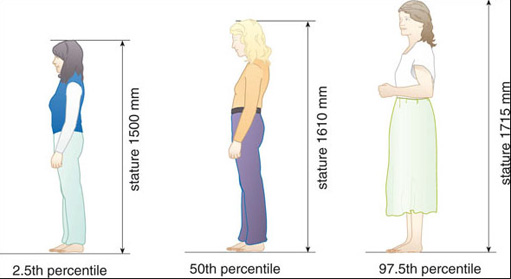
The idea of a percentile is quite straightforward. It is that proportion of the population under consideration with a dimension at or less than a given value. So, for example, if the 95th percentile for the standing height of a population is 1795 mm, then 95 per cent of that population are 1795 mm or shorter.
This is shown graphically in Figure 7. The horizontal axis shows what percentage of the total population reach a particular height and the vertical axis represents a range of different standing heights. From this figure you can see that 95 per cent of this particular population are 1795 mm or less tall, whereas only 5 per cent are 1605 mm or less, and 50 per cent are 1700 mm or less. Therefore, someone with a standing height of 1605 mm is at the 5th percentile, someone 1700 mm tall is on the 50th percentile and someone 1795 mm tall is at the 95th percentile of this population.
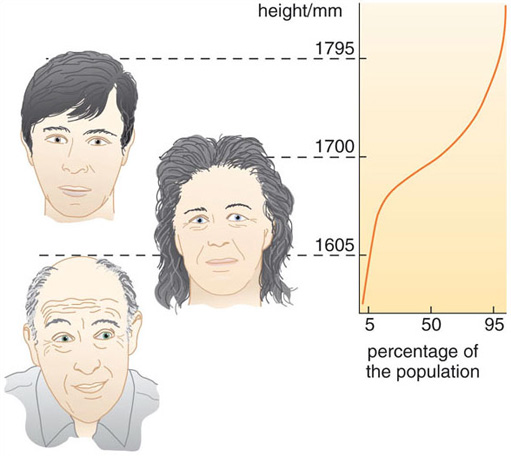
Test your understanding
Why should designers not design for the average user?
Answer
My response
Through focusing on the average user, the producers and designers of products may be overlooking the needs of large sections of the population. Design needs to take into consideration the variations due to size, age and disability, and other factors such as circumstances of use and strength.
6 Inclusive design
This section reveals the importance of designing things to suit all potential users.
Inclusive design (or universal design) means designing products so that they can be used easily by as many people as wish to do so. This may sound an obvious goal, but the fact is that many people – some estimates suggest as many as one-fifth of all adults – have difficulty carrying out ordinary tasks with everyday products.
Many elderly and disabled people cannot carry out – certainly with any ease or dignity – the range of everyday tasks that others take for granted. They are forced to choose products from a limited range that may suit them, and may also have to adapt products themselves, or buy expensive attachments to compensate for a product's inadequate design.
Figure 8 shows a radio with do-it-yourself adaptations made for an elderly user with poor eyesight and arthritis. Some buttons are covered to avoid accidental pressing, which would lose the preset channel, while others have high-visibility stick-on covers. Instructions for retuning the radio presets are attached for carers in case the user does press the wrong buttons. The end of the aerial is padded to avoid accidental eye damage to the user.
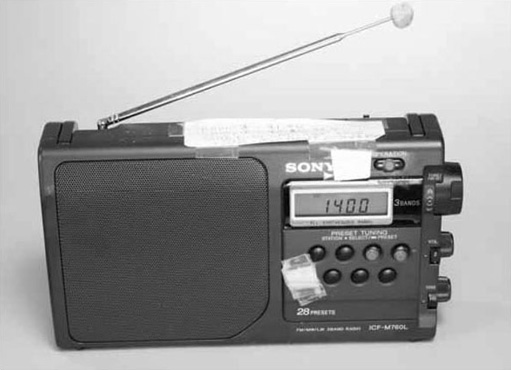
Recall from Section 3 that the Good Grips vegetable peeler originated by observing the difficulties of someone with arthritis using a conventional peeler. Many producer companies have begun to realise that excluding major sections of the population of potential users of their products is not only unjust but also bad business sense. As the populations in industrialised countries continue to age, there is a growing commercial case for inclusive design. By 2015, nearly twenty percent of the population of Europe will be aged 65 or over. They will be more active, and have more purchasing power, than previous elderly generations, and will be less tolerant of product designs that ‘exclude’ them.
Case study 2 Inclusive power tools
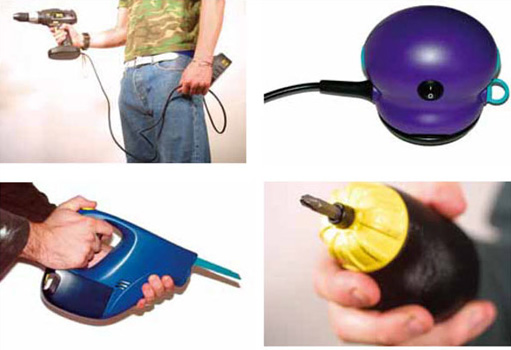
Click on the 'View document' link below to read a case study on power tools.
7 Ergonomics and human factors
This section discusses designing for human capabilities and limitations. It introduces the study of ergonomics which can offer general guidelines as well as specific suggestions for good, user-centred product design.
Taking the user as the central point of reference for the design and evaluation of products is the approach encouraged by ergonomists.
The field of ergonomics (also known as human factors engineering) is the systematic study of human capabilities, limitations and requirements, and the application of such knowledge to design. The name comes from the Greek ergos, meaning work, and nomos, laws. So it means, literally, the laws of work. This title reflects the origins of the approach, which lay in attempts to improve the performance efficiency of industrial workers and military personnel, through rational, scientific enquiry into human needs and behaviour.
There are two things, therefore, that distinguish ergonomics both from other professional design approaches and from common sense. Firstly, satisfaction of relevant user requirements is the overriding criterion, and secondly, the approach is based on the application of scientific enquiry to the problem of ascertaining human performance, abilities and limitations.
A simple example will illustrate the principles of how ergonomics can be applied in design. Figure 10 shows two designs for pliers.
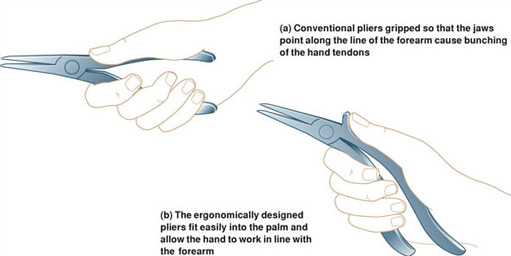
The pair at the top are a familiar conventional design, which appears to make good economic and practical sense. The tool is made in two identical parts, therefore minimising production costs, joined with a pivot. The overall form has evolved over generations from crude forebears such as blacksmiths’ tools and acquired a certain elegance and wholeness in its appearance. The design looks as if it has reached an end point in the process of evolution towards a perfect form. The pair below, on the other hand, look awkward and are made out of two very different halves. Yet trials have shown this ergonomically designed pair are more comfortable and efficient to use than their classical predecessors. The reason the conventional design is inferior is because to use it you have to bend your wrist in such a way as to cause unnecessary strain. The ergonomic design is based on studies of the anatomy of the hand, wrist and arm, in particular how the muscles and tendons operate, and the study of how people hold and use pliers.
8 Interaction design
8.1 Making usable products
This section reveals that many modern products need to usable by our minds as much as our bodies. Products need to be understandable, and present information and feedback in meaningful ways.
A lot of ergonomics research is aimed at establishing guidelines, standards or rules that can be applied by designers in a variety of situations. Where this applies to the physical use of products, much of it is based on standard body measurements. These body measurements are known as anthropometrics.
In performing tasks, many other human factors besides physical height, reach, etc, have to be taken into account by equipment designers. The growth of applications of computers, and the incorporation of microprocessors in products, has meant that interaction design has become a major new area of application for human factors research. Many of us now use information technology devices either directly, such as in computer work, or indirectly in products that have embedded computers. We interact with products daily – from setting a clock-radio or the central heating, to using cash-point machines or buying goods on the Internet – and so interaction design has become a part of the design of most electronic products.
Interaction design is concerned with the usability of products and machines, particularly with respect to how they present information to users and respond to commands and inputs from the user.
If you wish, this would be a good point to watch a short video clip from Phillip Joe, (former) Head of Interaction Design at IDEO Product Development, London.
8.1.1 Visibility
Recall that a key usability design feature identified by Donald Norman – from his analysis of using everyday objects such as doors – was visibility. An everyday object such as a door, or a control such as a button on a product should appear to be obvious about how it is used, and indeed it should perform that obvious function. For example, is it obvious how you insert a disc into a player? Is it obvious how you switch the machine on, adjust volume, and so on?
8.1.2 Feedback
A second important principle is providing feedback to the user – for example, when you press a button it moves and clicks, or you hear some other sound or you see a light to indicate the action has been registered by the machine.
Here's another short video clip from Phillip Joe at IDEO, this time on feedback.
8.1.3 Affordance
A third key design feature for usability is affordance – this more difficult concept is related to the functions that a product offers, or affords, to its users. Some affordances are real – for example a handle on a portable machine. Some are perceived affordances – these can be more relevant in computerised products, which have more complex and dynamic means of interaction with the user. For these products, it is important for the designer to help the user to perceive just what functions the product affords. Donald Norman defines affordance as:
Strong clues to the operation of things … When affordances are taken advantage of, the user knows what to do just by looking: no picture, label, or instruction is required.
For many common types of controls on machines, we expect that certain actions, such as turning or sliding them in certain directions, will produce expected kinds of results. Expectations that are found to be widespread in a population are know as conventions or stereotypes.
Example
Consider the arrangement in this example; which way would you turn the knob to make the pointer on the dial rotate from 1 to 6?
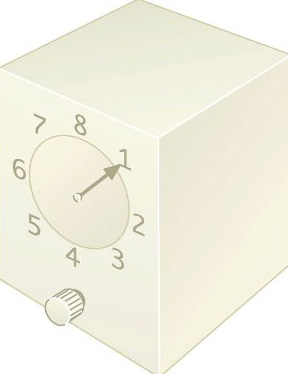
Answer
You would almost certainly say clockwise, because the mechanism here takes advantage of two strong conventions. It is normal to expect the pointer to move in the same direction as the knob. Also, people tend to associate clockwise rotation with the actions of on and increase, such as with the on-off volume controls of a radio.
There are, however, situations in which these conventions are reversed. For instance, in which direction do you turn on a water tap? It is usually anticlockwise, yet I'm sure you don't think every time you turn on a tap that it works in reverse. Generally speaking, the convention is usually anticlockwise for on when dealing with fluids and gases, and clockwise when dealing with mechanical and electrical devices. But there are many variations. For example, a pair of handles on either side of a mixer tap usually turn in contra-directions relative to each other – clockwise and anticlockwise – to turn them on, because it seems more intuitive that both should appear to turn towards or away from yourself to produce the same effect. There are also different cultural conventions – for example, electric switches are flicked down for on in Europe, but up for on in the USA.
The arrangements in this example summarise the most common and unambiguous stereotypes for relations between controls and displays.
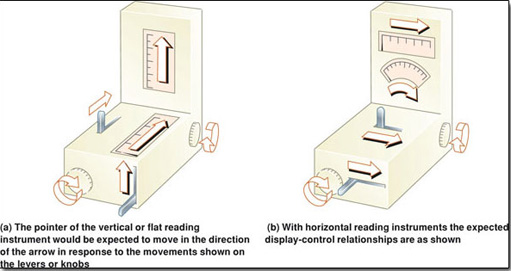
Stereotypes or conventions can be displaced by alternative learnt responses, but they frequently reassert themselves under conditions of stress such as tiredness or panic. Surveys have shown that many errors made by pilots interpreting aircraft instruments result from operating the controls in the wrong direction in response to a visual cue. In another typical example, a hydraulic press was wrecked by its operator. The press was operated by a lever that had to be moved down to raise the ram. One day, when an emergency occurred, the operator panicked and pulled the lever up to raise the ram. It, of course, came down.
The designers of the instrumentation on modern cars pay (or SHOULD pay) close attention to stereotypes, conventions, visibility, affordance and our expectations for feedback.
9 User research techniques
9.1 User trip
This section introduces a simple method of investigating product use. Even such simple methods can provide useful information to guide product redesign and new product development.
The essential idea of user trips is simple: you just take a ‘trip’ through the whole process of using a particular product or system, making yourself a critical observant user.
The only way to learn how to make these user trips is to try one or two for yourself. You will be surprised how much you find out, if you make yourself sufficiently self-aware and observant. In fact, after trying this method a few times, you will probably find that you are adopting an attitude to most of the products and systems used in everyday life, that other people might regard as hypercritical. But it is this attitude of constructive discontent, this dissatisfaction with the accepted norms, that spurs designers to make improvements. The secret is to turn dissatisfaction into creative criticism.
9.1.1 Point of view
Decide first of all which user's point of view you are taking: consumer, operator, maintenance person, and so on. You may want to make several trips, from different user perspectives, or try special user perspectives, such as that of a disabled person. It is usually easiest to take a consumer's trip because you may need special permission, access, and perhaps skills, before you can take any other.
9.1.2 Limits
Second, decide the limits and the variations to the user trip or trips that you are going to take. It is usually a good idea to extend the trip into activities that both precede and succeed the immediate use of the product you are investigating since this may lead you into devising an improved, more integrated overall solution. Similarly, variations on a basic trip – different times of day, different weather conditions, different requirements – will probably bring to light a wider range of problems than would a single, random trip.
9.1.3 Take the trip
Third, set out and take the trip and record actions, impressions, ideas and thoughts.
9.1.4 Take a trip to the payphone
Click on the 'View document' link below to read 'Take a trip to the payphone'.
Test your understanding
Summarise the three main stages in a user trip as described here.
Answer
My response
Decide on point(s) of view you will adopt for the user or users.
Decide on the limits and the variations to the user trip or trips you are going to take.
Carry out the trip or trips, recording your actions, impressions, thoughts and ideas.
9.1.5 Immersion
Click on the 'View document' link below to read Jordan on 'Immersion'.
User trips and immersion can generate a surprisingly high number of ideas for improvements to everyday products. This is particularly so if you can adopt a naive or inexperienced user approach to the product, but this is not always easy. Quite apart from the difficulty of adopting a genuinely naive approach, user trips and immersion suffer from a number of shortcomings that limit their usefulness.
Test your understanding
Can you think of any of the shortcomings referred to above?
Answer
My response
It is often difficult to do something and record your thoughts about it at the same time.
As we have seen, a single product can have many different kinds of users and it is often difficult to take the viewpoint of a user who has a role different from your own.
A naive user may make silly mistakes that an experienced user would not, therefore obtaining a wrong impression of the product.
10 User research techniques: observing users
This section introduces an alternative to basing user research on yourself. This is observation of experienced and inexperienced users either in experimental or natural situations.
One way around the difficulties of basing research on oneself is to observe other people acting as users and to choose naive or different kinds of experienced users, depending on what information you want to gather.
Begin by identifying those experienced users who will be able to provide you with relevant information. Most people are usually willing to cooperate and speak their minds if approached tactfully and with obvious good intent. It is as well to have a short list of questions you want to cover when consulting users, but avoid, for these purposes, a formal, rigorous questionnaire. Stick at first to unstructured discussions with the users, and get them to describe and comment on what seems important to them, as well as on what you regard as important.
Record what you are told, and your impressions of what you are told, during or immediately after the consultation.
As experienced users will have adapted themselves to the job or situation, or may consider it not worth commenting on certain aspects, you should combine or follow your consultation with some observation of the users in action. Look for, and ask about, aspects that seem difficult or unusual or critical. Look also for informal modifications to the job, work space or equipment that the user may have made for themselves – for example a hand-made sign or label on a machine, additional loose cushions on a seat, and so on. You should also record relevant circumstantial information, such as the user's age, sex, experience, the time of day, weather, and so on.
Also, an amazing amount of information relevant to the redesign of a product or system often can be gained from observing inexperienced users’ attempts to cope. Inexperienced users can reveal potentially important problems, difficulties, ideas, etc of which experienced users will be unaware.
Finding an inexperienced user is not always easy, but there may be ways of lowering a user's normal level of experience by introducing some novel feature. Acting as an inexperienced user, and perhaps being made to look naive or foolish, can be embarrassing, too. You should reassure your volunteers – and maybe yourself – you are looking for shortcomings in the product design, not in the users, and they should blame the design of the product, not themselves, for any difficulties.
Once you have found volunteers, give them only the basic objective they have to achieve, without any detailed instructions. Such an objective might be, ‘programme this VCR to record a programme on BBC 1 from 9.00pm to 10.00pm next Wednesday’ (assuming they are not familiar with the machine); or ‘listen to the voice-mail message that has been received on this telephone, and send a short text reply’.
You need to observe and record carefully what the inexperienced user does. Get your volunteers to talk about the task as they attempt it. You may find it takes what you would regard as an extraordinary amount of time for an inexperienced user successfully to operate something you are familiar with yourself, and your volunteer may actually be unable to achieve a seemingly simple objective. Don't offer advice if your volunteers get stuck – unless it looks as though they will cause damage or an injury, or until it would be more fruitful to move on to the next stage of a sequence of operations. Try not to laugh or get angry. Remember the advice about blaming the design, not the user.
Click on the 'View document' link below to read, an example of observation research watching users of digital cameras.
As well as conducting special experiments with selected users of a product or machine, it can be informative to record what happens during normal use, by making observations of typical users at work. This is sometimes called an ethnographic approach, because it relies on observing and recording peoples' normal, everyday behaviour.
If you wish, watch this short video clip from Alison Black at IDEO.
11 Designing for pleasure
11.1 The four pleasures
In consumerist societies, buying, using and displaying products has come to represent a certain type of pleasure. This pleasure principle has to be acknowledged in new product development and design. The designer Kenneth Grange has said that a guiding design principle for him is that a product should be ‘a pleasure to use’.
The pleasures of using a product are derived from the perceived benefits it offers to the user. Can we be more explicit in planning product benefits that are pleasurable? What is pleasure in this sense anyway? The following extract from Patrick Jordan's book Designing Pleasurable Products outlines four types of pleasure.
A useful way of classifying different types of pleasure has been espoused by Canadian anthropologist Lionel Tiger. Tiger has made an extensive study of pleasure and has developed a framework for addressing pleasure issues, which he outlines in some depth in the book The Pursuit of Pleasure. The framework models four conceptually distinct types of pleasure – physical, social, psychological and ideological. Summaries of Tiger's descriptions of each are given below. Examples are added to demonstrate how each of these components might be relevant in the context of products.
12 The voice of the customer
12.1 Gathering data
In this section I will review some of the approaches and methods used by companies for identifying and exploiting marketing opportunities.
All over the world, producer companies have increasingly learned to keep a careful watch on emerging consumer requirements and changing user needs and wishes. They have not only learned to listen to what consumers say, but to watch what they do. Techniques used in market research to gather consumers’ views on products include both quantitative methods (collecting numerical data), such as survey questionnaires, and qualitative methods (collecting opinions and subjective responses), such as focus groups.
12.1.1 Survey questionnaires
Questionnaires are lists of questions that enable information to be gathered efficiently from a relatively large number of respondents. Most questionnaires require a fixed type of response, such as a choice between available answers, or along a scale of response. For example, a product design questionnaire might suggest, ‘I found the product easy to use’ and provide a five-point scale of response from ‘agree strongly’ to ‘disagree strongly’. Or a question might be, ‘how often do you use the product?’, with responses such as ‘every day’, ‘most days’, ‘about once a week’, ‘once every couple of weeks’, ‘once a month or less’. A realistic and comprehensive range of responses must be available to the respondents – it would be pointless to offer responses to the frequency-of-use question of just ‘often’ or ‘never’. Sometimes, bipolar scales are used; these offer opposing poles of response, with perhaps a five-point scale spanning between the poles. For example, respondents might be asked to assess a product on bipolar scales such as ‘ugly-pretty’, ‘clumsy-elegant’, ‘comfortable-uncomfortable’, ‘easy-difficult’. Advantages of fixed-response types of questionnaires are they are quick to complete, lend themselves to easy processing of the responses, and result in numerical data.
Another type of questionnaire asks for open-ended responses, with questions such as, ‘are there any features of the product that you dislike?’, or, ‘would you recommend this product to a friend – if so, why?’. Open-ended questionnaires can provide useful insights gleaned from the responses, or can provide data such as how often a product feature is mentioned in free responses. But they require more processing of the responses, and provide more qualitative feedback and less numerical data than fixed-response questionnaires.
12.1.2 Focus groups
A focus group is simply a group of people gathered together to discuss a particular issue. They have been used in all kinds of social and market research, including political policy making. In market research for product design, a focus group might be a group of purchasers of a particular product brought together to discuss their feelings and attitudes towards the product and rival products; or perhaps their general likes and dislikes about those types of products. The intention of the market researchers is to gather information that might be useful in understanding consumer choices, and providing pointers for product improvements and new product developments.
A focus group would typically have between six to a dozen participants and a discussion leader, in this case the market researcher. The leader will have a list of issues to guide the discussion, but will allow the participants to develop their own topics of discussion, so as to let the discussion go in directions favoured by the participants. Examples of particular products to be discussed will usually be available.
As group facilitator, the discussion leader tries to ensure that everyone has the opportunity to voice their opinions, and that everyone feels able to raise issues they want to discuss. However, the leader will normally have a set of prompts in case discussion dries up – but it is important that any such prompts are used merely to trigger discussion from the participants, rather than to suggest what those responses might be. Often, this is a matter of phrasing the prompt appropriately. Therefore, for example, rather than asking, ‘do you think the material of the handle gives it a high quality, comfortable feel?’, the prompt should be, ‘when you hold it, what do you feel about the quality of the handle – and why?’. The leader's aim is to phrase the prompt in a neutral way, like a genuine query, rather than leading participants into particular responses.
Phillips is one of the world's leading consumer product manufacturers. This extended video clip gives an insight to a variety of techniques they use to uncover the needs and wants of their consumers.
13 Products for markets
Japanese car companies came to dominate in many countries in the 1980s, and this was in part attributable to their marketing research and emphasis on designing products for particular market segments. An example is the car firm Nissan, which researches national preferences for various car attributes in different countries. For instance, it is reputed to have provided its cars with softer suspensions in Germany, firmer steering in the UK, and noisier exhausts in Italy. There are other reasons for the success of Japanese companies, such as their product quality and reliability, but an approach of lifestyle analysis has been used widely by Japanese companies to design products for markets.
For example, the lifestyle design method has been used by the GK-Kyoto company (Figure 13). This method uses lifestyle collages – paste-ups of pictures of people, products, situations, and so on, that reflect a particular lifestyle; designers sometimes call these mood boards (another example of the use of these boards can be seen on the Phillips video clip). Here, the boards present formal lifestyle ‘maps’ of typical life situations, based on contrasting key-words or images of lifestyle.
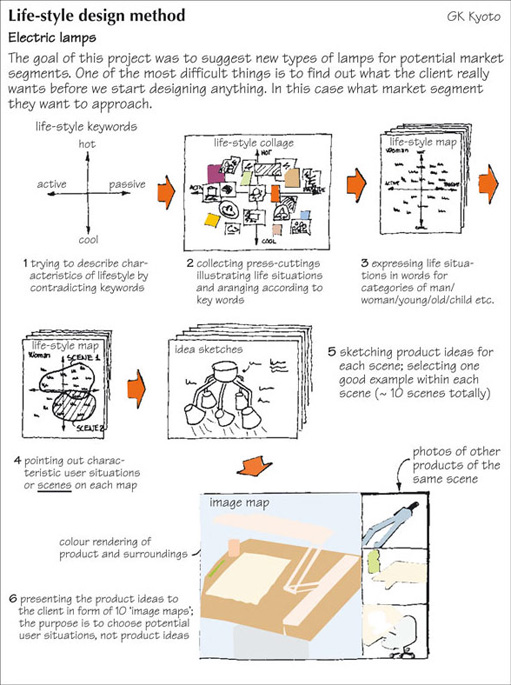
From these lifestyle maps, characteristic user situations are identified for which there may be new product opportunities. Consideration of these user situations or scenarios, perhaps in creative brainstorming sessions with designers and/or users can lead to product ideas. Images of these potential products in their use situations are then created before finally deciding on a product to develop through to marketing tests.
Companies use market research to identify different market segments, and provide a range of differentiated products to appeal to different consumers within these market segments. This is market segmentation and product differentiation. Techniques such as focus groups and surveys are used in market research to capture the voice of the customer – meaning comments and opinions that influence consumer choice and that need to be taken into account in product planning and design. Other techniques include analysis of consumer lifestyles or ‘kansei engineering’ approaches to identify areas for product improvement or suggest opportunities for the development of new products.
Click on the 'View document' link below to read: 'Kansei Engineering'.
Conclusion
Products that display some type of human interaction acknowledge that human beings have a physical form. Our human form gives rise to design restrictions and limitations. Our physical forms differ considerably from one person to the next and our own physical form changes over time. As a consequence of our different physical forms we have different physical abilities. For example, we differ in our reach, our strength, our ability to grip and our ability to sustain effort. To draw a distinction between able-bodied and disabled is too simplistic. Designers need to consider the physical characteristics of all those who may interact with their products – old, young, male, female, large and small. We all have abilities and disabilities!
Designing calls into play our interpretative processes. We display these when we act as designers and when we consume design. All information received by the senses is processed and interpreted. In some ways our interpretations are broadly similar to those of other people – especially where we share a common culture; in other ways our interpretations are unique because our personal circumstances and life events are unique.
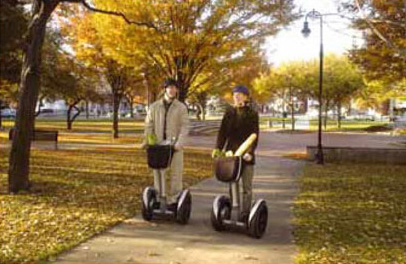
When people refer to the function of an object they are usually thinking of the practical, utilitarian functions. However, the psychological function of a product, that is, what associations it has for us, what values we give it and what its shapes, materials, textures and colours mean to us are equally important. User research must apply and develop techniques that uncover the real phychological needs and requirments of users. Producers must learn to apply the findings of user research in a process of user-centred design.
This short video clip reveals how organisations such as Phillips are changing their work processes in response to new priorities for user centred design.
Designing is a process of finding a balance between factors. Nevertheless, the ‘human factors’ of design are some of the most important factors we need to take into account in designing things.
There are various career opportunities in this field. In this short video clip Monica Bueno outlines her career that has led to her working at Phillips.
If you want to know more about studying design at the Open University visit the Courses and Qualifications website.
Keep on learning

Study another free course
There are more than 800 courses on OpenLearn for you to choose from on a range of subjects.
Find out more about all our free courses.
Take your studies further
Find out more about studying with The Open University by visiting our online prospectus.
If you are new to university study, you may be interested in our Access Courses or Certificates.
What’s new from OpenLearn?
Sign up to our newsletter or view a sample.
For reference, full URLs to pages listed above:
OpenLearn – www.open.edu/ openlearn/ free-courses
Visiting our online prospectus – www.open.ac.uk/ courses
Access Courses – www.open.ac.uk/ courses/ do-it/ access
Certificates – www.open.ac.uk/ courses/ certificates-he
Newsletter – www.open.edu/ openlearn/ about-openlearn/ subscribe-the-openlearn-newsletter
References
Acknowledgements
Except for third party materials and otherwise stated (see terms and conditions), this content is made available under a Creative Commons Attribution-NonCommercial-ShareAlike 4.0 Licence.
Course image: Peter Corbett in Flickr made available under Creative Commons Attribution-NonCommercial-ShareAlike 2.0 Licence.
The material acknowledged below is Proprietary and used under licence (not subject to Creative Commons Licence). Grateful acknowledgement is made to the following sources for permission to reproduce material in this free course:
Grateful acknowledgement is made to the following sources:
Text
Case Study 2: Inclusive power tools, The Design Council.
Figures
Figure 1: Bayer plc
Figure 2: OXO Good Grips
Figure 6 Diffrient, N., Tilley, A.R. and Bardagjy, J.C. ‘Humanscale 1/2/3: A portfolio of information’, 1974, MIT Press
Figure 10 Helen Hamlyn Research Centre and B&Q
Figure 13 Buur, J., ‘Mechatronics Design in Japan’, 1989, Denmark, Technical University of Denmark
Figure 14 Segway™ LLC
Every effort has been made to contact copyright owners. If any have been inadvertently overlooked, the publishers will be pleased to make the necessary arrangements at the first opportunity.
Don't miss out
If reading this text has inspired you to learn more, you may be interested in joining the millions of people who discover our free learning resources and qualifications by visiting The Open University – www.open.edu/ openlearn/ free-courses.
Copyright © 2016 The Open University
